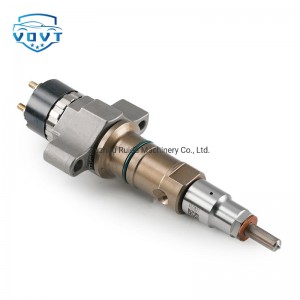New High Quality Diesel Nozzle DLLA141P2146 for Injection Nozzle Diesel Engine Parts
Products Description
| Reference. Codes | DLLA141P2146 |
| Application | / |
| MOQ | 12PCS |
| Certification | ISO9001 |
| Place of Origin | China |
| Packaging | Neutral packing |
| Quality Control | 100% tested before shipment |
| Lead time | 7~15 working days |
| Payment | T/T, L/C, Paypal, Western Union, MoneyGram or as your requirement |
How to optimize the performance of fuel injector nozzles?
Structural Parameter Optimization: Precisely Matching Combustion Requirements
Nozzle Shape and Layout Design
A convergent-divergent nozzle (first converging to a minimum diameter and then slightly expanding) accelerates fuel flow through the Venturi effect, increasing exit velocity by 15%-20% and reducing atomized particle size to 8-15μm.
The number and angle of nozzles are optimized for different combustion chambers (such as direct injection and pre-combustion chambers). Direct-injection diesel engines use a 6-8-hole fan-shaped layout (with a cone angle of 140°-160°) to ensure that the oil mist covers the entire piston cavity. Pre-combustion chamber models use a 2-4-hole straight-injection design to enhance flame propagation efficiency.
The hole spacing deviation is controlled to ≤0.05mm to avoid spray interference and the formation of localized concentrated areas, reducing soot emissions by over 10%. Optimized flow chamber and needle valve seat surface
The flow chamber adopts a hemispherical transition structure to reduce fuel flow resistance and lower nozzle inlet pressure loss by 12%;
The needle valve seat surface features a slightly convex design (curvature radius 5-8mm), combined with a 0.005mm sealing band width, ensuring high-pressure sealing while reducing fuel residue and lowering the risk of carbon deposits.
Materials and Surface Treatment: Improving Wear and Corrosion Resistance
High-Performance Base Material Selection
The nozzle plate is constructed from powder metallurgy high-speed steel (such as ASP-60) or tungsten carbide-based cemented carbide, achieving a hardness exceeding HV2000 and offering erosion resistance three times greater than traditional 4Cr13 steel.
For highly corrosive fuels such as biodiesel, Hastelloy C276 is selected as the base material, offering five times greater corrosion resistance and preventing nozzle deformation caused by acid erosion. Application of Advanced Coating Technology
A diamond-like carbon (DLC) coating is deposited on the inner wall of the nozzle hole, with a thickness controlled to 3-5μm and a surface roughness reduced to below Ra0.01μm. This not only reduces fuel flow resistance but also improves wear resistance by 5-8 times.
A multi-layer gradient coating (bottom layer CrN + middle layer TiAlN + top layer DLC) solves the problem of insufficient adhesion between a single coating and the substrate, extending the coating life to over 2,000 hours.
Manufacturing Process Innovation: Ensuring Precision and Consistency
High-Precision Forming Technology
Laser drilling technology has been upgraded to ultrashort pulse laser (pulse width < 10ps), achieving a diameter tolerance of ±0.003mm for nozzles sized 0.08-0.2mm and a hole roundness of ≤0.002mm, eliminating uneven spray caused by dimensional deviations.
3D printing technology is used to manufacture the integrated fuel injector nozzle (including the guide cavity and nozzle hole), creating a seamless complex flow path. This improves fuel flow uniformity by 20% and keeps pressure fluctuations within ±3%. Ultra-precision machining and inspection
The inner wall of the nozzle hole uses an electrolytic polishing process to remove micro-burrs left by laser machining, achieving a surface finish of Ra 0.008μm and reducing turbulent dead zones.
X-ray 3D imaging inspection accurately identifies defects as small as 0.001mm within the nozzle hole, ensuring a product qualification rate of ≥99.5% for each batch.
Dynamic Adaptation and Intelligent Control: Coping with Complex Operating Conditions
Variable Needle Valve Lift Technology
Using dual springs or piezoelectric actuators, the needle valve lift is dynamically adjustable from 0.1 to 0.4mm. At idle, a small lift (0.1-0.15mm) reduces fuel injection and lowers HC emissions; at high speeds and high loads, a large lift (0.3-0.4mm) increases flow and improves power response. Adaptive Spray Control
A micro pressure sensor and thermocouple integrated into the fuel injector monitor injection pressure and combustion chamber temperature in real time, dynamically adjusting the injection pulse width and pressure via the ECU:
During cold starts, injection pressure is increased to 2500 bar and pulse width is shortened to ensure adequate atomization.
At high altitudes, the number of pre-injections is increased (2-3 times) to compensate for combustion delays caused by insufficient oxygen.
Anti-carbon deposit and self-cleaning design
The nozzle outlet features an inverted cone angle (15°-20°) to reduce fuel residue adhesion.
Regular high-temperature post-injection (once every 100 kilometers) utilizes exhaust heat to ablate carbon deposits on the nozzle surface, maintaining a stable spray pattern.
Fuel Compatibility Optimization: Adapting to Diverse Fuels
High-Viscosity Fuel Compatibility
For biodiesel, heavy fuel oil, and other fuels, a PTC heating element is built into the nozzle to control the fuel temperature at 50-70°C, reducing viscosity to 20-30 mm²/s, ensuring smooth injection.
The nozzle inlet chamfer (R0.05mm) is increased to reduce flow resistance for high-viscosity fuels.
Clean Fuel Injection Optimization
For hydrogen-diesel blends, the nozzle diameter is reduced to 0.08-0.12mm, coupled with a higher injection pressure (3000 bar) to prevent localized lean burn caused by excessive hydrogen diffusion.





















